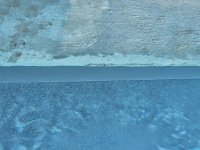New pool owner. (2 months)
Started noticing concrete bullnose edges were turning white and chipping off a little. So, I started reading on LSI and water balance. Pool guy and pool store don't seem too concerned (or dont care) about LSI, but I am now because I'm pretty sure my water was corrosive due to low calcium.
Raised calcium to 120 because that's pool manufacturer recommendation. But based on that level, consi stently having high PH (7.8-8.0) due to saltwater, and high temp (84°), adding muriatic acid to lower my ph will make my water corrosive. They keep telling me to lower my ph because fiberglass recommendations are 7.2 -7.6, but that just wouldn't work with my water readings.
stently having high PH (7.8-8.0) due to saltwater, and high temp (84°), adding muriatic acid to lower my ph will make my water corrosive. They keep telling me to lower my ph because fiberglass recommendations are 7.2 -7.6, but that just wouldn't work with my water readings.
FC - 2.5
TA - 90
PH - 7.9
CH - 120
Salt - 2400
CYA - 36
My concern is...which is worse? Low calcium or high PH? I can't seem to keep ph low cuz of the saltwater. It goes right back up day after adding acid, and I'm not sure I want to add acid everyday. Plus, it lowers my alkalinity. How do I keep ph stable and within 7.2 - 7.6 range? Seems impossible with the saltwater. Will adding calcium affect the fiberglass? Will high ph affect the fiberglass? So much info and opinions have me overwhelmed.
I just don't want any more damage to my new concrete, which I need to have sealed anyway. I've included a picture.
Any help from a fiberglass saltwater pool owner would help. Thank you.
Started noticing concrete bullnose edges were turning white and chipping off a little. So, I started reading on LSI and water balance. Pool guy and pool store don't seem too concerned (or dont care) about LSI, but I am now because I'm pretty sure my water was corrosive due to low calcium.
Raised calcium to 120 because that's pool manufacturer recommendation. But based on that level, consi
 stently having high PH (7.8-8.0) due to saltwater, and high temp (84°), adding muriatic acid to lower my ph will make my water corrosive. They keep telling me to lower my ph because fiberglass recommendations are 7.2 -7.6, but that just wouldn't work with my water readings.
stently having high PH (7.8-8.0) due to saltwater, and high temp (84°), adding muriatic acid to lower my ph will make my water corrosive. They keep telling me to lower my ph because fiberglass recommendations are 7.2 -7.6, but that just wouldn't work with my water readings.FC - 2.5
TA - 90
PH - 7.9
CH - 120
Salt - 2400
CYA - 36
My concern is...which is worse? Low calcium or high PH? I can't seem to keep ph low cuz of the saltwater. It goes right back up day after adding acid, and I'm not sure I want to add acid everyday. Plus, it lowers my alkalinity. How do I keep ph stable and within 7.2 - 7.6 range? Seems impossible with the saltwater. Will adding calcium affect the fiberglass? Will high ph affect the fiberglass? So much info and opinions have me overwhelmed.
I just don't want any more damage to my new concrete, which I need to have sealed anyway. I've included a picture.
Any help from a fiberglass saltwater pool owner would help. Thank you.


 Help me with that photo. How old is your pool? Is that fiberglass above the waterline or something rise? It has a plaster look to it.
Help me with that photo. How old is your pool? Is that fiberglass above the waterline or something rise? It has a plaster look to it.